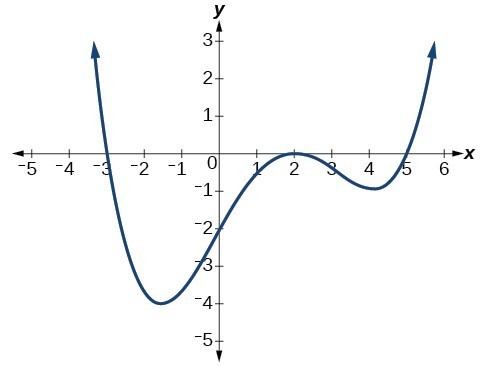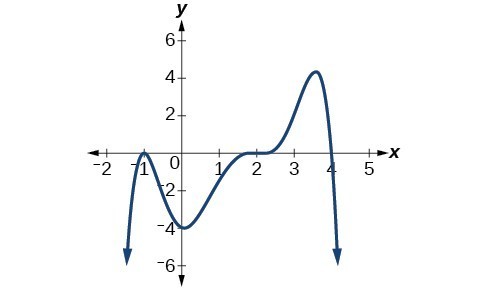Writing Formulas for Polynomial Functions
Learning Objectives
- Write the equation of a polynomial function given it's graph
A General Note: Factored Form of Polynomials
If a polynomial of lowest degree p has horizontal intercepts at [latex]x={x}_{1},{x}_{2},\dots ,{x}_{n}[/latex], then the polynomial can be written in the factored form: [latex]f\left(x\right)=a{\left(x-{x}_{1}\right)}^{{p}_{1}}{\left(x-{x}_{2}\right)}^{{p}_{2}}\cdots {\left(x-{x}_{n}\right)}^{{p}_{n}}[/latex] where the powers [latex]{p}_{i}[/latex] on each factor can be determined by the behavior of the graph at the corresponding intercept, and the stretch factor a can be determined given a value of the function other than the x-intercept.How To: Given a graph of a polynomial function, write a formula for the function.
- Identify the x-intercepts of the graph to find the factors of the polynomial.
- Examine the behavior of the graph at the x-intercepts to determine the multiplicity of each factor.
- Find the polynomial of least degree containing all the factors found in the previous step.
- Use any other point on the graph (the y-intercept may be easiest) to determine the stretch factor.
Example: Writing a Formula for a Polynomial Function from the Graph
Write a formula for the polynomial function.
Answer: This graph has three x-intercepts: x = –3, 2, and 5. The y-intercept is located at (0, 2). At x = –3 and x = 5, the graph passes through the axis linearly, suggesting the corresponding factors of the polynomial will be linear. At x = 2, the graph bounces at the intercept, suggesting the corresponding factor of the polynomial will be second degree (quadratic). Together, this gives us [latex-display]f\left(x\right)=a\left(x+3\right){\left(x - 2\right)}^{2}\left(x - 5\right)[/latex-display] To determine the stretch factor, we utilize another point on the graph. We will use the y-intercept (0, –2), to solve for a. [latex-display]\begin{array}{l}f\left(0\right)=a\left(0+3\right){\left(0 - 2\right)}^{2}\left(0 - 5\right)\hfill \\ \text{ }-2=a\left(0+3\right){\left(0 - 2\right)}^{2}\left(0 - 5\right)\hfill \\ \text{ }-2=-60a\hfill \\ \text{ }a=\frac{1}{30}\hfill \end{array}[/latex-display] The graphed polynomial appears to represent the function [latex]f\left(x\right)=\frac{1}{30}\left(x+3\right){\left(x - 2\right)}^{2}\left(x - 5\right)[/latex].
Try It 5
Given the graph below, write a formula for the function shown.
Answer: [latex]f\left(x\right)=-\frac{1}{8}{\left(x - 2\right)}^{3}{\left(x+1\right)}^{2}\left(x - 4\right)[/latex]
Key Takeaways
Use Desmos to help you write the equation of a degree 5 polynomial function with roots at [latex](-1,0),(0,2),\text{and },(0,3)[/latex] that passes through the point [latex](1,-32)[/latex].Answer: [latex-display]f(x)=-2(x-2)(x+1)^3(x-2)[/latex-display]
Using Local and Global Extrema
With quadratics, we were able to algebraically find the maximum or minimum value of the function by finding the vertex. For general polynomials, finding these turning points is not possible without more advanced techniques from calculus. Even then, finding where extrema occur can still be algebraically challenging. For now, we will estimate the locations of turning points using technology to generate a graph. Each turning point represents a local minimum or maximum. Sometimes, a turning point is the highest or lowest point on the entire graph. In these cases, we say that the turning point is a global maximum or a global minimum. These are also referred to as the absolute maximum and absolute minimum values of the function.Local and Global Extrema
A local maximum or local minimum at x = a (sometimes called the relative maximum or minimum, respectively) is the output at the highest or lowest point on the graph in an open interval around x = a. If a function has a local maximum at a, then [latex]f\left(a\right)\ge f\left(x\right)[/latex] for all x in an open interval around x = a. If a function has a local minimum at a, then [latex]f\left(a\right)\le f\left(x\right)[/latex] for all x in an open interval around x = a. A global maximum or global minimum is the output at the highest or lowest point of the function. If a function has a global maximum at a, then [latex]f\left(a\right)\ge f\left(x\right)[/latex] for all x. If a function has a global minimum at a, then [latex]f\left(a\right)\le f\left(x\right)[/latex] for all x. We can see the difference between local and global extrema below.
Q & A
Do all polynomial functions have a global minimum or maximum? No. Only polynomial functions of even degree have a global minimum or maximum. For example, [latex]f\left(x\right)=x[/latex] has neither a global maximum nor a global minimum.Example: Using Local Extrema to Solve Applications
An open-top box is to be constructed by cutting out squares from each corner of a 14 cm by 20 cm sheet of plastic then folding up the sides. Find the size of squares that should be cut out to maximize the volume enclosed by the box.Answer:
We will start this problem by drawing a picture like the one below, labeling the width of the cut-out squares with a variable, w.
 Notice that after a square is cut out from each end, it leaves a [latex]\left(14 - 2w\right)[/latex] cm by [latex]\left(20 - 2w\right)[/latex] cm rectangle for the base of the box, and the box will be w cm tall. This gives the volume
[latex-display]\begin{array}{l}V\left(w\right)=\left(20 - 2w\right)\left(14 - 2w\right)w\hfill \\ \text{ }=280w - 68{w}^{2}+4{w}^{3}\hfill \end{array}[/latex-display]
Notice that after a square is cut out from each end, it leaves a [latex]\left(14 - 2w\right)[/latex] cm by [latex]\left(20 - 2w\right)[/latex] cm rectangle for the base of the box, and the box will be w cm tall. This gives the volume
[latex-display]\begin{array}{l}V\left(w\right)=\left(20 - 2w\right)\left(14 - 2w\right)w\hfill \\ \text{ }=280w - 68{w}^{2}+4{w}^{3}\hfill \end{array}[/latex-display]
 Notice, since the factors are w, [latex]20 - 2w[/latex] and [latex]14 - 2w[/latex], the three zeros are 10, 7, and 0, respectively. Because a height of 0 cm is not reasonable, we consider the only the zeros 10 and 7. The shortest side is 14 and we are cutting off two squares, so values w may take on are greater than zero or less than 7. This means we will restrict the domain of this function to [latex]0<w<7[/latex]. Using technology to sketch the graph of [latex]V\left(w\right)[/latex] on this reasonable domain, we get a graph like Figure 24. We can use this graph to estimate the maximum value for the volume, restricted to values for w that are reasonable for this problem—values from 0 to 7.
From this graph, we turn our focus to only the portion on the reasonable domain, [latex]\left[0,\text{ }7\right][/latex]. We can estimate the maximum value to be around 340 cubic cm, which occurs when the squares are about 2.75 cm on each side. To improve this estimate, we could use advanced features of our technology, if available, or simply change our window to zoom in on our graph to produce the graph below.
Notice, since the factors are w, [latex]20 - 2w[/latex] and [latex]14 - 2w[/latex], the three zeros are 10, 7, and 0, respectively. Because a height of 0 cm is not reasonable, we consider the only the zeros 10 and 7. The shortest side is 14 and we are cutting off two squares, so values w may take on are greater than zero or less than 7. This means we will restrict the domain of this function to [latex]0<w<7[/latex]. Using technology to sketch the graph of [latex]V\left(w\right)[/latex] on this reasonable domain, we get a graph like Figure 24. We can use this graph to estimate the maximum value for the volume, restricted to values for w that are reasonable for this problem—values from 0 to 7.
From this graph, we turn our focus to only the portion on the reasonable domain, [latex]\left[0,\text{ }7\right][/latex]. We can estimate the maximum value to be around 340 cubic cm, which occurs when the squares are about 2.75 cm on each side. To improve this estimate, we could use advanced features of our technology, if available, or simply change our window to zoom in on our graph to produce the graph below.
![Graph of V(w)=(20-2w)(14-2w)w where the x-axis is labeled w and the y-axis is labeled V(w) on the domain [2.4, 3].](https://s3-us-west-2.amazonaws.com/courses-images/wp-content/uploads/sites/896/2016/11/02201637/CNX_Precalc_Figure_03_04_0292.jpg) From this zoomed-in view, we can refine our estimate for the maximum volume to about 339 cubic cm, when the squares measure approximately 2.7 cm on each side.
From this zoomed-in view, we can refine our estimate for the maximum volume to about 339 cubic cm, when the squares measure approximately 2.7 cm on each side.
Try It
Click on the graph below to find the maximum and minimum values on the interval [latex]\left[-2,7\right][/latex] of the function [latex]f\left(x\right)=0.1{\left(x - \frac{5}{3}\right)}^{3}{\left(x+1\right)}^{2}\left(x - 7\right)[/latex]. Then, use the slider to see how changing the value of a effects the end behavior and y-intercept of the graph. https://www.desmos.com/calculator/5oyyx0vbivAnswer: The minimum occurs at approximately the point [latex]\left(5.98,-398.8\right)[/latex], and the maximum occurs at approximately the point [latex]\left(0.02,3.24\right)[/latex].
Licenses & Attributions
CC licensed content, Original
- Revision and Adaptation. Provided by: Lumen Learning License: CC BY: Attribution.
- Interactive: Zeros of a Polynomial. Authored by: Lumen Learning (With Desmos). License: CC BY: Attribution.
CC licensed content, Shared previously
- College Algebra. Provided by: OpenStax Authored by: Abramson, Jay et al.. Located at: https://openstax.org/books/college-algebra/pages/1-introduction-to-prerequisites. License: CC BY: Attribution. License terms: Download for free at http://cnx.org/contents/[email protected].
- Question ID 29478. Authored by: McClure, Caren. License: CC BY: Attribution. License terms: IMathAS Community License CC-BY + GPL.
